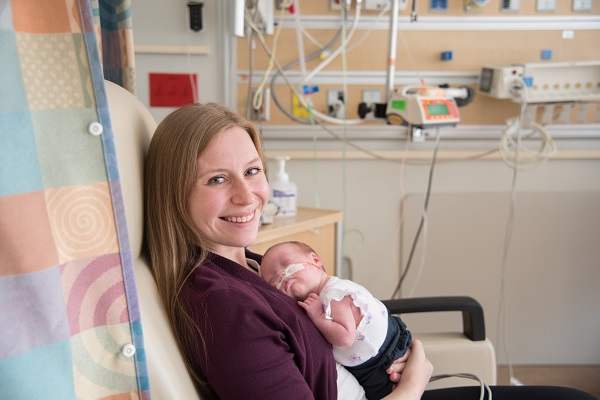By Erinor Jacob-Levine
Kaća Tepavac was born at 27 weeks and spent the first few months of her life in the Neonatal Intensive Care Unit (NICU) at London Health Sciences Centre’s (LHSC) Children’s Hospital. During her stay, she and the other babies in the NICU rely upon their mom’s breastmilk for nutrients to help them continue to grow and get strong. The stored breastmilk from the mom’s is prepared and delivered by the infant feeding assistants in the Women & Infants Program.
This program supports the feeding of babies including those in the NICU with mom’s breastmilk. It is located in the food services department at LHSC’s Victoria Hospital and works in conjunction with the NICU dietitian to ensure babies like Kaća receive the milk they need to grow stronger.
The babies at LHSC have specific dietary requirements which can need updating three times a day by the NICU dietitian. These dietary requirements can include human milk fortifier, protein and formula to the specific feed size. On average the program provides support to over 40 patients a day. With so many patients it is important to keep the breastmilk properly labelled, stored and prepared.
“Safety is paramount to us,” says Lindsay Botnick, program manager. Properly tracking, storing and preparing the milk has required the program to upgrade its freezer and electronic tracking system over the past few years. As human milk is a body fluid, the system was implemented to prevent the potential transmission of communicable diseases and other serious infections that can have lifelong implications by ensuring the mom’s milk goes to her baby.
For Kaća’s mom, Brittany Freake, the process gave her a sense of ease and appeals to her engineer’s mind. It makes sense to her, that with so many mothers and babies there would be a system to safely track the milk. “Lots of things seem out of your control, but I didn’t have to worry about the feeding,” says Brittany. In the NICU, she was impressed when she saw how the nurses scanned everything to ensure it was going to the right baby, including the milk.
The process in place ensures safety and quality throughout the management of the milk to help protect the patients. Mom’s are given containers with labels to place the milk they have pumped into. These labels record the date and time of when the milk was pumped, and name of the patient. They are stored in a fridge or freezer until a member of the Women & Infants Program collects them and brings them to the program’s area.
The infant feeding assistants scan the milk into the computer tracking program. They record the weight of the milk, the date and time it was pumped, and whether it is in a frozen or liquid state. The containers receive a new label and the week they were pumped is written on the lid. They go into the large freezer for storage. The recording of this data is important because the nutritional value of the mother’s milk changes weekly, even daily after the baby’s birth.
An infant feeding assistant will prepare up to three times per day for each infant. The milk is taken from the large freezer and placed in one of three fridges, marked Frozen, Thaw, and Prepped. The milk is thawed in the fridge, or if required quickly, in the breastmilk warmer machine. The container is scanned to ensure the appropriate milk is being used. If an incorrect container has been scanned a large red warning sign will appear.
An infant feeding assistant measures and mixes the appropriate milk and supplements, placing them in syringes, which most NICU babies require. Appropriate labels identifying the patient name and barcode for scanning is placed on the feed which is stored in the prepped fridge to be sent to the floor where it will be scanned again and the name checked prior to feeding. By preparing three feeds a day, the feeding assistants are able to adapt quickly to the baby’s changing nutritional needs and ensure minimal wastage of mom’s milk.
Any excess milk is stored in the large freezer until mom and baby are ready to leave. Mom has the option to take the milk home in insulated boxes and use at a later date, or donate to the milk bank.
While the NICU is the primary client of the Women & Infants Program, they also provide support to inpatient babies and mom’s including the Paediatric Critical Care Unit. This Program is helping ensure some of LHSC’s most vulnerable paediatric patients, like Kaća, who went home in early September, safely get the nutrition they need.
Erinor Jacob-Levine works in communications at London Health Sciences Centre.


